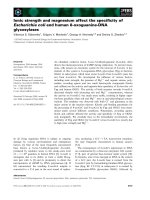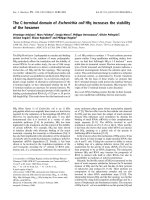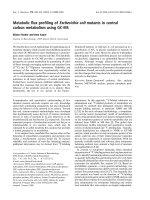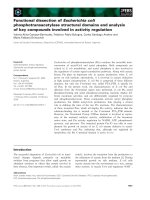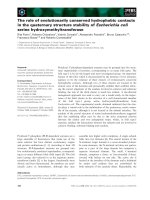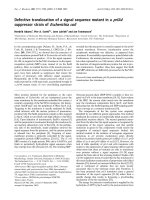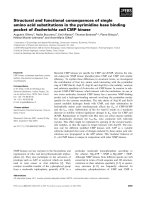Inactivation of escherichia coli and listeria innocua in kiwifruit and pineapple juices by high hydrostatic pressure
Bạn đang xem bản rút gọn của tài liệu. Xem và tải ngay bản đầy đủ của tài liệu tại đây (360.89 KB, 4 trang )
International Journal of Food Microbiology 124 (2008) 275–278
Contents lists available at ScienceDirect
International Journal of Food Microbiology
j o u r n a l h o m e p a g e : w w w. e l s ev i e r. c o m / l o c a t e / i j f o o d m i c r o
Inactivation of Escherichia coli and Listeria innocua in kiwifruit and pineapple juices
by high hydrostatic pressure
Sencer Buzrul a,b,⁎, Hami Alpas b, Alain Largeteau a, Gérard Demazeau a
a
b
ICMCB, CNRS, Université Bordeaux 1, site de l'ENSCPB, 87 avenue du Dr. A. Schweitzer, 33608 PESSAC cedex, France
Food Engineering Department, Middle East Technical University, 06531 Ankara, Turkey
A R T I C L E
I N F O
Article history:
Received 22 November 2007
Received in revised form 20 February 2008
Accepted 24 March 2008
Keywords:
High hydrostatic pressure
Pulse pressure treatment
Kiwifruit juice
Pineapple juice
E. coli
L. innocua
A B S T R A C T
Escherichia coli and Listeria innocua in kiwifruit and pineapple juices were exposed to high hydrostatic
pressure (HHP) at 300 MPa for 5 min. Both bacteria showed equal resistance to HHP. Using low (0 °C) or subzero (−10 °C) temperatures instead of room temperature (20 °C) during pressurization did not change the
effectiveness of HHP treatment on both bacteria in studied juices. Pulse pressure treatment (multiple pulses
for a total holding time of 5 min at 300 MPa) instead of continuous (single pulse) treatment had no
significant (p N 0.05) effect on the microbial inactivation in kiwifruit juice; however, in pineapple juice pulse
treatment, especially after 5 pulses, increased the inactivation significantly (p b 0.05) for both bacteria.
Following storage of pressure-treated (350 MPa, 20 °C for 60 s × 5 pulses) juices at 4, 20 and 37 °C up to
3 weeks, the level of microbial inactivation further increased and no injury recovery of the bacteria were
detected. This work has shown that HHP treatment can be used to inactivate E. coli and L. innocua in kiwifruit
and pineapple juices at lower pressure values at room temperature than the conditions used in commercial
applications (N 400 MPa). However, storage period and temperature should carefully be optimized to increase
the safety of HHP treated fruit juices.
© 2008 Elsevier B.V. All rights reserved.
1. Introduction
Consumer demand for freshly-squeezed fruit juices is increasing, but
such products are susceptible to spoilage and thus have a limited shelflife (Jordan et al., 2001). High hydrostatic pressure (HHP) is one of the
non-thermal, alternative methods that has emerged and can give a
response to the increasing consumer demand for fresh and minimally
processed food products. The application of HHP treatment ranging
from 100 to 1000 MPa allows preservation of foods without altering the
quality and has a comparable preservation effect with thermal
treatment (Buzrul et al., 2007a). Over the last 20 years the research
about HHP has been explored (Hayakawa et al., 1994; Palou et al., 1997;
Buzrul and Alpas 2004; Buzrul et al., 2005; Avsaroglu et al., 2006) and
several commercial products, including some fruit juices, treated by
HHP are now available on market. For example, mandarin and grapefruit
juices in Japan, apple juice in Portugal and Italy, orange juice in France
and United States, carrot juice and broccoli–apple juice mixture in Czech
Republic were introduced into the market throughout the years.
Kiwifruit can be considered as a highly nutritional product due to its
high level of vitamin C content and its strong antioxidant capacity. Based
on these characteristics, kiwifruit offers benefits for specific health
conditions and has a great potential for industrial applications (Cassano
et al., 2006); however, kiwifruit juice has no market worldwide. On the
⁎ Corresponding author. Food Engineering Department, Middle East Technical
University, 06531 Ankara, Turkey. Tel.: +90 312 210 5638; fax: +90 312 210 2767.
E-mail addresses: , (S. Buzrul).
0168-1605/$ – see front matter © 2008 Elsevier B.V. All rights reserved.
doi:10.1016/j.ijfoodmicro.2008.03.015
contrary, pineapple juice has been on the market shelves for some years,
principally because of its pleasant unique aroma and flavor. Nevertheless, the flavor of pineapple fruit is extremely sensitive to changes
taking place during heat treatment (de Barros et al., 2003).
Some strains of Escherichia coli, including the pathogenic O157:H7
strain, are acid-resistant and can survive for long periods in acid foods,
especially at low temperature (Glass et al., 1992; Miller and Kaspar,
1994; Jordan et al., 2001). Listeria spp. is not known to have caused
outbreaks through the consumption of fruit juices but has been
isolated from unpasteurized apple juice (Sado et al., 1998).
Since complexity and the cost of pressure equipment rise more than
linearly with the maximum operating pressure, the main requirement
to make HHP process economically sustainable is the “reduction of the
pressure level” necessary to attain a “commercially suitable microbial
inactivation level” on the food processed. The objective of this study
was to examine the pressure inactivation of E. coli and L. innocua in
kiwifruit and pineapple juices and if possible use lower pressure values
than the ones used in commercial applications. Furthermore, it was
aimed to investigate the effect of storage on the survival of these
microorganisms in both juices at different temperatures.
2. Materials and methods
2.1. Preparation of bacterial species
The microorganisms used were E. coli ATCC 11775 and L. innocua
ATCC 33090 (both from E.R.A.P. laboratory—Périgueux, France). A
276
S. Buzrul et al. / International Journal of Food Microbiology 124 (2008) 275–278
previous study by Buzrul et al. (2007b) indicated that these strains are
relatively resistant to pressure. The strains were maintained on tryptic
soy agar plus 0.6% yeast extract (TSAYE) (Merck, Darmstadt, Germany)
slants. For growth, a loopful of each organism was transferred to tubes
of tryptic soy broth supplemented with 0.6% yeast extract (TSBYE)
(Merck, Darmstadt, Germany), kept at 37 °C for 15–21 h and
transferred to fresh broth every 48 h for use in this study.
Kiwifruits and pineapples were obtained from a local market. They
were washed, peeled, cut and pulped using a hand-held bar kitchen
blender (Moulinex, Barcelona, Spain). Then the pulp–juice mixtures of
each fruit was filtered through a cheese cloth to remove the pulp. The
juices obtained were further filtered (Minisart®, 0.45 μm, Sartorius,
Goettingen, Germany) for sterilization and stored at 4 °C until use. pH
of the kiwifruit and pineapple juices were 3.32 and 3.77, respectively.
Each juice was inoculated with pure cultures from the early stationary
phase to obtain about 107 colony forming units (CFU) mL− 1 juice at
least 1 h before treatment to allow cells to adapt to the new
environment. One milliliter of un-inoculated juice was transferred
onto TSAYE plates (Sterilin, Staffordshire, UK) and incubated at 37 °C
for 48 h to make sure that the juice samples were sterile.
cells to form visible colonies. All experiments were repeated once
more and the averages were determined.
2.2. HHP treatment
3. Results and discussion
The cell suspensions were dispensed in 6 mL-portions in sterile
plastic vials (Nunc, Roskilde, Denmark) in duplicate. Air bubbles were
avoided. The vials were vacuum sealed in sterile plastic bags (Fischer
Scientific, PA) and kept at 4 °C prior to pressurization that did not
exceed 1 h. Pressurization of samples was carried out using a
computer controlled high pressure unit with 3 L sample compartment,
capable of operating at up to 800 MPa and designed by NFMTechnologies (Le Creusot, France) and FRAMATOME (Paris, France),
marketed by CLEXTRAL (Firminy, France). The pressure transmitting
fluid was selected as ethylene glycol; since it has higher viscosity than
water it is possible to prevent any leakage of the liquid from the
pressure vessel. Moreover, it remains liquid at sub-zero temperatures
and hence allows one to perform experiments at low tempertaures.
Although the maximum compression and release rate was 375 MPa/
min, both come-up and pressure release rates were set to 300 MPa/
min due to safety considerations. Pressure and temperature were
measured using sensors inside and outside the high pressure vessel
and all data were stored in the computer system. In a first attempt, the
strains were pressurized in duplicate at 300 MPa for 300 s at 20, 0 and
−10 °C. Secondly, pulsed HHP treatment was applied at 300 MPa for a
total duration of 300 s with different pulse numbers at 20 and 0 °C
(150 s × 2 pulses, 100 s × 3 pulses, 75 s × 4 pulses, 60 s × 5 pulses, 50 s × 6
pulses and 30 s × 10 pulses; the last two pulse treatment were only
done at 20 °C). The pressure holding time reported in this study did
not include the process come-up or depressurization times. Temperature increases during pressurization due to adiabatic heat were
predetermined using a K-type thermocouple. Compression heating
during pressure was taken into consideration in the experiments so
that temperature of the pressure transmitting fluid during HHP
treatment was controlled near experimental temperatures (the
temperature increase of ethylene glycol–pressure transmitting fluid–
and fruit juices were about 4.0 °C/100 MPa and 3.3 °C/100 MPa,
respectively. However, this was highly dependent on the initial
temperature of these liquids).
Immediately after pressure treatment, the vials were transferred to
ice–water mixture. Cell suspensions from each vial was serially
diluted in 0.1% peptone water (Biokar, Beauvais, France) and each
dilution (from each sample) were surface plated in duplicate giving
four plates per dilution on prepoured TSAYE. With samples containing
less than 25 CFU mL− 1 in a 1:10 dilution, 4 mL of undiluted cell
suspension was plated in twelve plates (0.3, 0.3 and 0.4 mL in
quadruplicate). The plates were incubated at 37 °C for 72 h,
respectively prior to colony enumeration in order to allow injured
3.1. Effect of temperature on inactivation of E. coli and L. innocua in fruit
juices
2.3. Storage of HHP treated juices
Samples of inoculated juices were pressure-treated at 350 MPa for
60 s × 5 pulses at 20 °C and held at 4, 20 and 37 °C for 28 days. At 1st,
7th, 14th and 21st days of storage 1 mL (0.3, 0.3 and 0.4 mL) of both
juice were surface plated on prepoured TSAYE. The plates were
incubated at 37 °C for 72 h and examined for presence (+) or absence
(−) of colony formation on agar plates.
2.4. Statistical analyses of the data
Analysis of variance (ANOVA) as implemented in SPSS 10.0 for
Windows (SPSS, Inc, Chicago, USA) was used to test effects of
temperature, microorganisms and fruit juices on the logarithmic
survival ratio. Tukey, Duncan and Student–Newman–Keuls post-hoc
tests were used as paired comparisons between sample means. Level
of significance was set to 0.05.
Fig. 1 shows the 5 min HHP treatment (300 MPa) at three
temperature values. Experimental data indicate that both bacteria had
almost equal resistance to HHP. This was also reported by Buzrul et al.
(2007b) in whole milk for the same strains of these bacteria. It was
also observed that microbial inactivation in kiwifruit juice was greater
than the inactivation in pineapple juice treated by HHP. Moreover,
temperature had no significant (p N 0.05) impact on the microbial
inactivation; i.e., using low (0 °C) or sub-zero (−10 °C) temperatures
instead of room temperature (20 °C) during pressurization did not
change the effectiveness of HHP treatment. In literature conflicting
data exist about the high pressure low temperature processes. Yuste et
al. (2002), for example, reported that pressurization at 20 °C is more
lethal than at − 20 °C for the inactivation of mesophilic and
psychrotrophic microflora of mechanically recovered poultry meat.
On the other hand, Moussa et al. (2006) observed that pressurization,
in the range of 100 to 300 MPa, at −20 °C (in the liquid state) is more
lethal than at 25 °C for inactivation of E. coli; however, at higher
pressures this trend was reversed.
Fig. 1. Inactivation levels of E. coli (black color in kiwifruit juice, white color in pineapple
juice) and L. innocua (dark gray color in kiwifruit juice, light gray color in pineapple
juice) in fruit juices at 300 MPa for 5 min at different temperature values. Error bars
represent 95% confidence intervals.
S. Buzrul et al. / International Journal of Food Microbiology 124 (2008) 275–278
277
3.2. Effect of pulse HHP treatment
Different combinations of pulse holding times and number of
pulses were applied with a total holding time of 5 min at 300 MPa
(300 s × 1 pulse, 150 s × 2 pulses, 100 s × 3 pulses, 75 s × 4 pulses,
60 s × 5 pulses, 50 s × 6 pulses and 30 s × 10 pulses; the last two pulse
treatment were only done at 20 °C) at 20 and 0 °C. Fig. 2 shows HHP
treatment at 20 °C up to 10 pulses at 300 MPa for 5 min; increasing
the pulse number did not effect the microbial inactivation to a great
extent in kiwifruit juice; however, in pineapple juice pulse treatment,
especially after 5 pulses, increased the inactivation significantly
(p b 0.05) for both bacteria. Fig. 3 shows HHP treatment at 0 °C up to 5
pulse treatment. The same observation is also valid for this
treatment.
The differences between kiwifruit and pineapple juices during
pulse HHP treatment could be explained by the variation of
resistance of each cell in a population. When all the weak
members of the population are destroyed (leaving behind survivors
of higher resistance) no further lethality occurs even if the number
of pulses is increased (Donsì et al., 2007). Most probably, all the
weak members were destroyed in kiwifruit juice even at single
pulse HHP treatment hence increasing the pulse number (up to 10
pulses) did not effect the microbial inactivation, but increasing the
pressure level may have some effect. In pineapple juice inactivation
increased especially after 5 pulse treatment, indicating that some
of the resistant cells of initial microbial population can be
destroyed by increasing the number of pulses and by decreasing
pulse holding time.
Fig. 3. Inactivation levels of E. coli (black color in kiwifruit juice, white color in pineapple
juice) and L. innocua (dark gray color in kiwifruit juice, light gray color in pineapple
juice) in fruit juices at 300 MPa, 0 °C for different pulse numbers. Error bars represent
95% confidence intervals.
According to Juice HACCP Hazards and controls guidance (Anonymous, 2004) 5 log10 reduction must be accomplished for fruit juices.
Since 300 MPa treatment did not allow this much reduction (see Figs.
1–3), pressure was increased to 350 MPa (to have a built-in safety
factor and to try 5 log10 reduction). In kiwifruit juice more than 5 log10
reduction was obtained at 350 MPa, 20 °C for 60 s × 5 pulses
immediately after HHP treatment; while about 2.5 and 3.5 log10
reductions were observed in pineapple juice for E. coli and L. innocua,
respectively. Inactivations were further increased more than 1 log10
during storage at 4 °C for 24 h for both bacteria in both juices (Fig. 4);
for kiwifruit juice no viable cells were observed (7 log10 reduction;
complete inactivation) after 24 h at 4 °C. This phenomenon
(inactivation increase during storage after HHP treatment) was also
observed by Jordan et al. (2001) for E. coli in orange, tomato and apple
juices.
The effect of storage temperature on the recovery of E. coli and L.
innocua after HHP treatment (350 MPa, 20 °C for 60 s × 5 pulses) was
also tested. Viability of both bacteria in both juices was reduced by
more than 7 log10 at all storage temperatures (except 4 °C in pineapple
juice) during the first 24 h. The subsequent storage enhanced further
inactivation even at 4 °C and no recovery of the bacteria were detected
during 3 weeks of storage at 4, 20 and 37 °C. This result indicates that
the HHP treatment caused sublethal injury to a large propotion of the
cells, resulting in a reduced resistance to low pH (Garcia-Graells et al.,
1998) during storage; however, storage temperature is an important
factor. In literature, it was reported that refrigeration enhances
survival of E. coli in acidic environments (Zhao and Doyle, 1993;
Miller and Kaspar, 1994; Conner and Kotrola, 1995) which was
confirmed in this study after HHP treatment for both E. coli and L.
innocua (in pineapple juice) for the first 24 h at 4 °C when compared
with 20 and 37 °C.
Inoculated juices without HHP treatment were also used to
discount the effect of the matrix on bacterial count and between
about half to one log10 reductions were observed for both bacteria in
both juices at different storage temperatures for a period of 1 week.
Fig. 2. Inactivation levels of E. coli (black color in kiwifruit juice, white color in pineapple
juice) and L. innocua (dark gray color in kiwifruit juice, light gray color in pineapple
juice) in fruit juices at 300 MPa, 20 °C for different pulse numbers. Error bars represent
95% confidence intervals.
Fig. 4. Inactivation levels of E. coli (black color in kiwifruit juice, white color in pineapple
juice) and L. innocua (dark gray color in kiwifruit juice, light gray color in pineapple
juice) in fruit juices at 350 MPa, 20 °C for 60 s × 5 pulses at 0 h and after 24 h at 4 °C. Error
bars represent 95% confidence intervals.
3.3. Effect of storage and storage temperature
278
S. Buzrul et al. / International Journal of Food Microbiology 124 (2008) 275–278
The inhibitory effect during storage is most probably due to the
combination of the impact of HHP treatment and low pH values of the
juices.
4. Conclusions
This work has shown that HHP treatment at room temperature
(20 °C) can be used to inactivate E. coli and L. innocua in kiwifruit and
pineapple juices at lower pressure values than the ones used in
commercial applications (N400 MPa). However, storage duration and
temperature should carefully be optimized to increase the safety of
HHP treated fruit juices.
Acknowledgments
This research work was developed in the scope of a thesis in cotutelle (S.B.) between the University Bordeaux 1 “Sciences and
Technologies” and the Middle East Technical University (METU). The
French Embassy in Ankara, Turkey is deeply acknowledged for this
support. Authors would like to thank Mr. Pierre Tyndiuk for his help
during pressurization experiments.
References
Anonymous, 2004. Food and Drug Administration, U.S., Center for Food Safety and
Applied Nutrion, February. Juice HACCP Hazards and Controls Guidance, First ed.
Avsaroglu, M.D., Buzrul, S., Alpas, H., Akcelik, M., Bozoglu, F., 2006. Use of the Weibull
model for lactococcal bacteriophage inactivation by high hydrostatic pressure.
International Journal of Food Microbiology 108, 78–83.
Buzrul, S., Alpas, H., 2004. Modeling the synergistic effect of high pressure and heat on
the inactivation kinetics of Listeria innocua: a preliminary study. FEMS Microbiology
Letters 238, 29–36.
Buzrul, S., Alpas, H., Bozoglu, F., 2005. Use of Weibull frequency distribution model to
describe the inactivation of Alicyclobacillus acidoterrestris by high pressure at
different temperatures. Food Research International 38, 151–157.
Buzrul, S., Alpas, H., Largeteau, A., Demazeau, G., 2007a. Mathematical expression of
the temperature profile and experimental determination of compression heating
of ethylene glycol during high hydrostatic pressure. High Pressure Research 27,
93–99.
Buzrul, S., Alpas, H., Largeteau, A., Demazeau, G., 2007b. Modeling high pressure
inactivation of Escherichia coli and Listeria innocua in whole milk European Food
Research and Technology. doi:10.1007/s00217-007-0740-7.
Cassano, A., Figoli, A., Tagarelli, A., Sindona, G., Drioli, E., 2006. Integrated membrane
process for the production of highly nutritional kiwifruit juice. Desalination 189,
21–30.
Conner, D.E., Kotrola, J.S., 1995. Growth and survival of Escherichia coli O157:H7 under
acidic conditions. Applied and Envrionmental Microbiology 61, 382–385.
Donsì, G., Ferrari, G., Maresca, P., 2007. Pulsed high pressure treatment for the
inactivation of Saccharomyces cerevisiae: the effect of process parameters. Journal of
Food Engineering 78, 984–990.
de Barros, S.T.D., Andrade, C.M.G., Mendes, E.S., Peres, L., 2003. Study of fouling
mechanism in pineapple juice clarification by ultrafiltration. Journal of Membrane
Science 215, 213–224.
Garcia-Graells, V., Hauben, E.J.A., Michiels, C.W., 1998. High pressure inactivation and
sublethal injury of pressure-resistant Escherichia coli mutants in fruit juices.
Applied and Envrionmental Microbiology 64, 1566–1568.
Glass, K.A., Loeffelholz, J.M., Ford, J.P., Doyle, M.P., 1992. Fate of Escherichia coli O157:H7
as affected by pH or sodium chloride and in fermented, dry sausage. Applied and
Envrionmental Microbiology 58, 2513–2516.
Hayakawa, I., Kanno, T., Yoshiyama, K., Fujio, Y., 1994. Oscillatory compared with
continuous high pressure sterilization on Bacillus stearothermophilus spores.
Journal of Food Science 59, 164–167.
Jordan, S.L., Pascual, C., Bracey, E., Mackey, B.M., 2001. Inactivation and injury of
pressure-resistant strains of Escherichia coli O157 and Listeria monocytogenes in
fruit juices. Journal of Applied Microbiology 91, 463–469.
Miller, L.G., Kaspar, C.W., 1994. Escherichia coli O157:H7 acid tolerance and survival in
apple cider. Journal of Food Protection 57, 460–464.
Moussa, M., Perrier-Cornet, J.-M., Gervais, P., 2006. Synergistic and antagonistic effects
of combined subzero temperature and high pressure on inactivation of Escherichia
coli. Applied and Environmental Microbiology 72, 150–156.
Palou, E., Lopez-Malo, A., Barbosa-Canovas, G.V., Welti-Chames, J., Swanson, B.G., 1997.
Combined effect of high hydrostatic pressure and water activity on Zygosaccharomyces balii inhibition. Letters in Applied Microbiology 24, 417–420.
Sado, P.N., Jinneman, K.C., Busby, G.J., Sorg, S.M., Omiecinski, C.J., 1998. Identification of
Listeria monocytogenes from unpasteurised apple juice using rapid test kits. Journal
of Food Protection 58, 1199–1202.
Yuste, J., Pla, R., Capellas, M., Mor-Mur, M., 2002. Application of high-pressure
processing and nisin to mechanically recovered poultry meat for microbial
decontamination. Food Control 13, 451–455.
Zhao, T., Doyle, M.P., 1993. Fate of enterohemorrhagic Escherichia coli O157:H7 in
commercial mayonnaise. Journal of Food Protection 57, 780–783.
